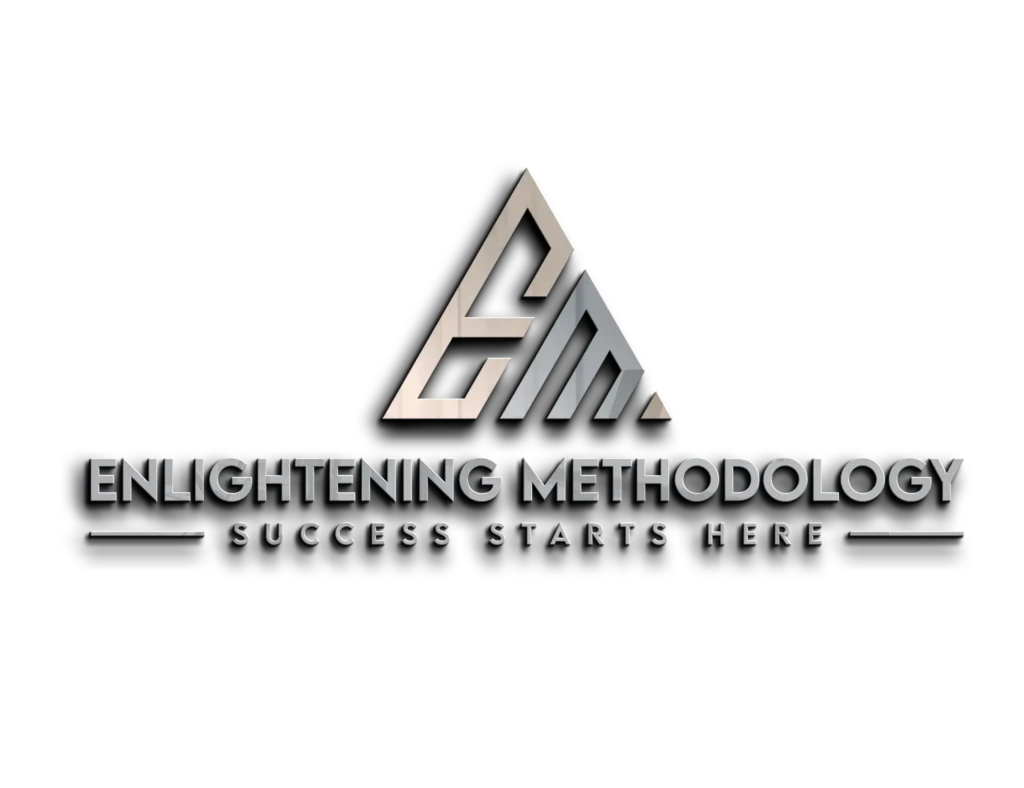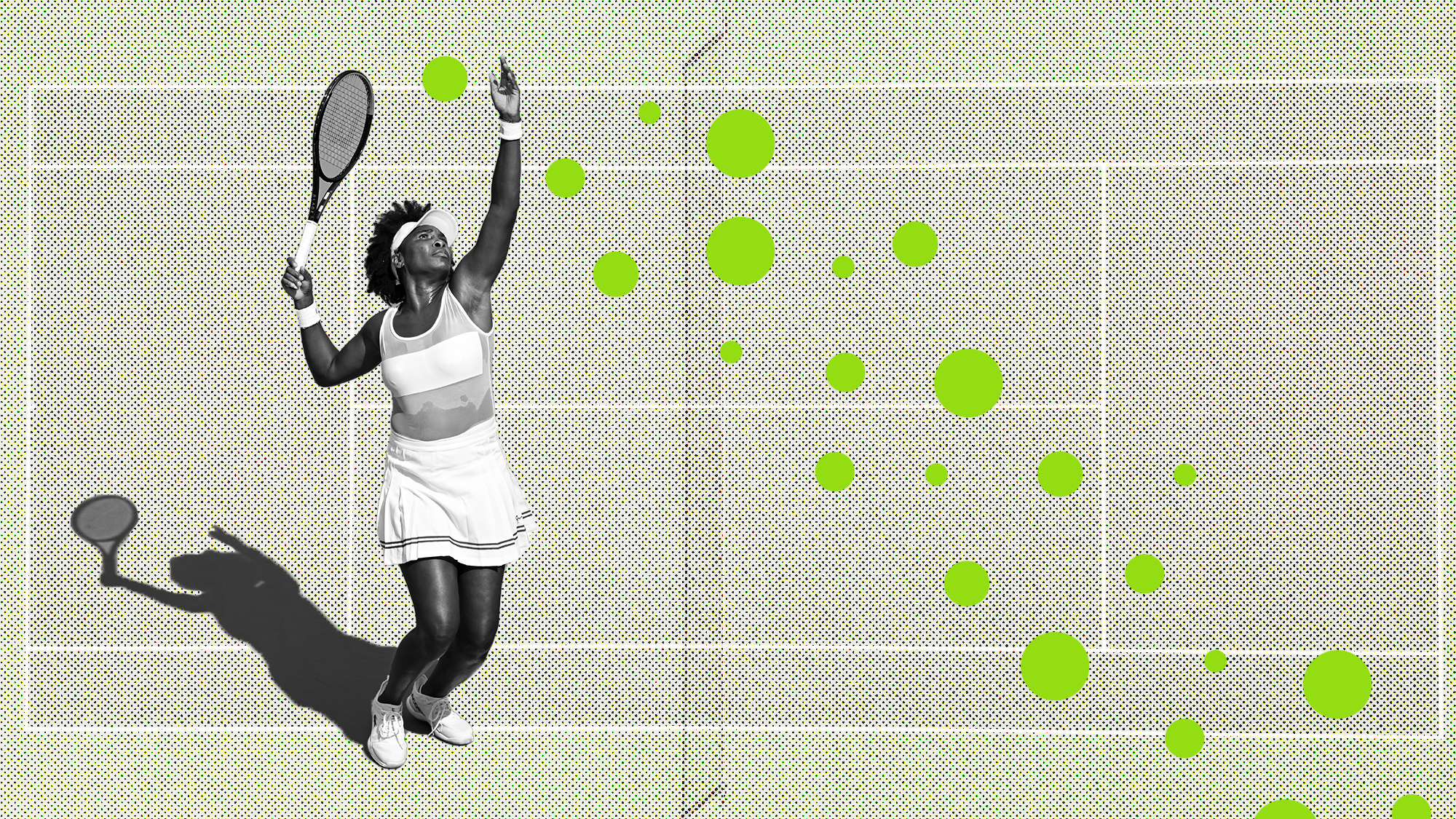Seamlessly sharing patient data across healthcare systems is more difficult than it should be.
But there’s real momentum toward change.
In June 2025, openEHR International and HL7 International met in Amsterdam to explore how their two leading standards, openEHR and FHIR, can be better aligned. This FHIR vs OpenEHR comparison has the potential to move health data interoperability from theory to practice.
FHIR moves the data. Together, they make FHIR vs OpenEHR for healthcare systems integration more connected and future-ready.
This guide talks about FHIR vs OpenEHR for clinical data integration and which data standard is fit for the future of interoperability.
What Led to This?
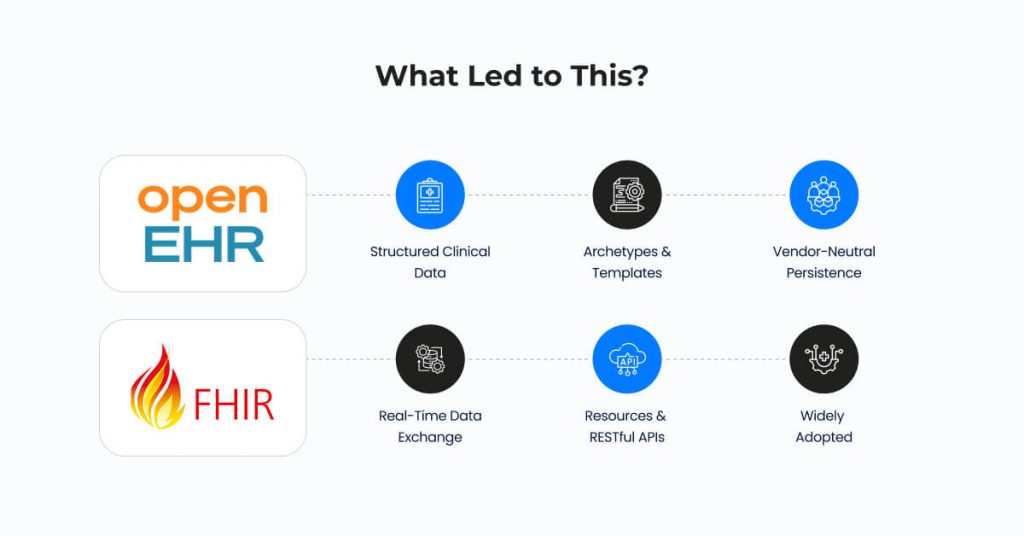
While both are open standards, they serve distinct purposes. One manages data at rest (openEHR); the other moves data across systems (FHIR).
1. openEHR
Emphasizes model-driven storage and management of clinical data in a structured format.
Supports rich clinical models with archetypes and templates.
Facilitates vendor-independent data persistence and reuse over the long term.
2. FHIR
Focuses on standardized digital exchange of data between stakeholders and systems.
Utilizes resources and RESTful APIs to make real-time calls.
Worldwide adoption of FHIR standard-based healthcare interoperability solutions, patient applications, and health networks at a national level.
Differences in Purpose and Application
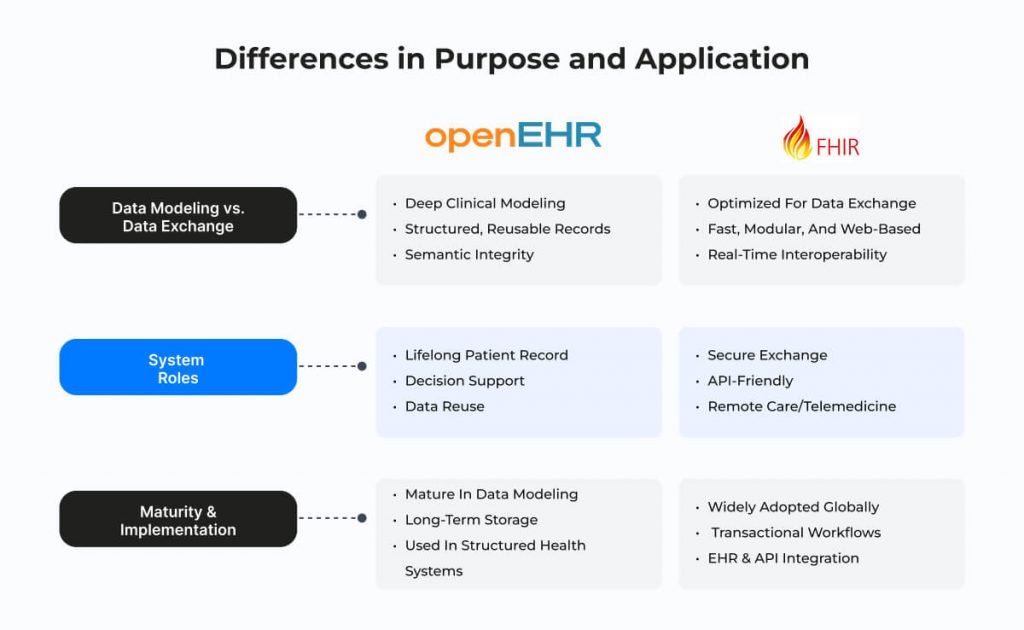
FHIR vs OpenEHR in electronic health records is not just a matter of preference; it reflects how systems prioritize interoperability vs data structure.
1. Data Modeling vs Data Exchange
openEHR is optimized for clinical depth, structured storage, and semantic integrity.
FHIR is optimized for FHIR integration, system interoperability, and real-time communication.
2. System Roles
openEHR facilitates the production of lifelong patient records, data reuse, and clinical decision support.
FHIR facilitates secure, rapid, and modular data exchange based on web technologies, crucial for telemedicine software solutions and remote patient monitoring.
3. Maturity and Implementation
openEHR is firmly established in data modeling and long-term record keeping.
FHIR has a wider global application for transactional workflows and EHR integration solutions.
Complementary Use: Combining Strengths
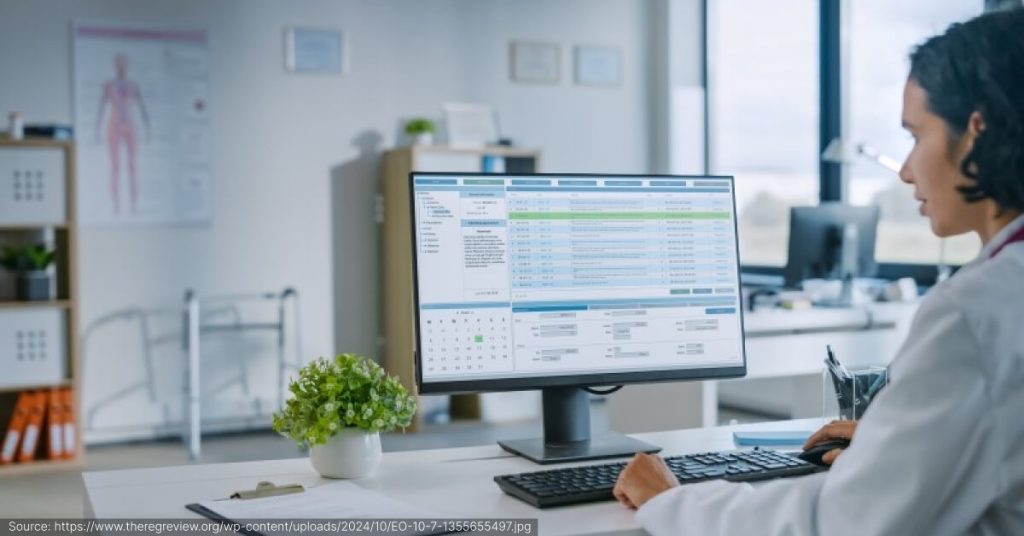
openEHR offers semantically valuable, structured data that enables in-depth care planning, analytics, and documentation of care.
FHIR enables the secure and nimble exchange of that data between stakeholders and systems, supporting FHIR vs OpenEHR for clinical data exchange.
1. Addressing the Interoperability Paradox
Using multiple standards can complicate integration, but a combined approach reduces the limitations of any single standard. Each standard is used in scenarios where it offers the greatest benefit, making FHIR vs OpenEHR for healthcare interoperability a critical conversation.
2. Practical Examples
A hospital has used openEHR to store patients’ clinical data.
The same hospital has used FHIR APIs to send discharge summaries to a general practitioner or a national network, demonstrating FHIR vs OpenEHR for patient data management in action.
Dutch Healthcare System: A Use Case
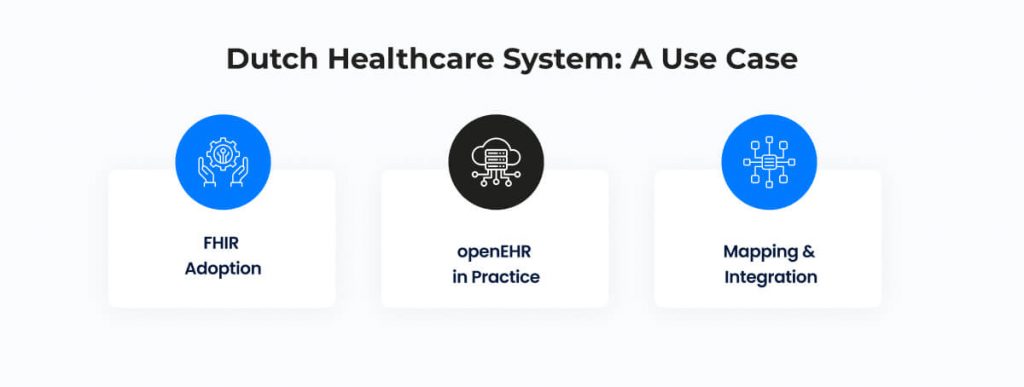
1. FHIR Adoption
The Dutch Ministry of Health has endorsed the FHIR standard for national data exchange.
Programs like MedMij rely on FHIR integration to enable patients to access their data across systems.
2. openEHR in Practice
openEHR is used for structured clinical data storage in selected projects and research environments.
Organizations such as Nictiz are studying how openEHR software can support structured, reusable health records.
3. Mapping and Integration
Organizations and vendors are already creating mappings between FHIR and OpenEHR for mobile health apps to facilitate effortless integration.
The benefits of FHIR vs OpenEHR become most apparent when blending the agility of FHIR with the deep clinical modeling of OpenEHR.
Strategic Collaboration: Goals and Benefits
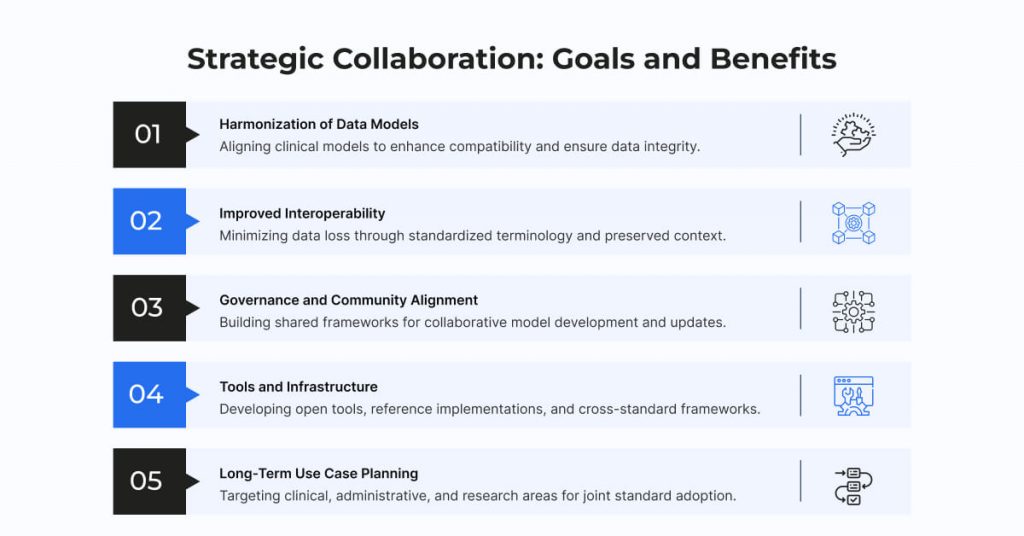
During the June 2025 workshop, HL7 and openEHR International established five collaborative focus areas jointly. Although definite details are pending, the goals can be illustrated as follows:
1. Harmonization of Data Models
Ensuring clinical content models align for greater compatibility and data integrity.
2. Improved Interoperability
Minimizing loss of data during conversion through the standardization of term usage and the preservation of context.
3. Governance and Community Alignment
Providing shared governance models for model updates and development.
4. Tools and Infrastructure
Developing reference implementations, transformation tools, and open frameworks for use across standards. These can support HL7 integration solutions and healthcare software development.
5. Long-Term Use Case Planning
Determining specific clinical, administrative, and research areas in which dual use of both standards will be the most beneficial.
To further understand how their standards can complement one another and enhance the sharing and utilization of health data, openEHR International and HL7 International convened a two-day workshop in Amsterdam in June 2025.
They had decided on five main areas of cooperation before the end of the program.
Dedicated teams from both sides are now starting work, with plans to review progress in mid-2026.
Key Points
- The two standards are different but can work well together: openEHR for data structure, and FHIR for data exchange.
- Both groups want to reduce data loss when converting between systems.
- They’re also looking at shared tools, long-term planning, and ways to keep the work community-led.
Two major health data communities are serious about making systems talk to each other better. It supports the idea that using both FHIR and openEHR is more than theory, it’s becoming real.
Limitations and Considerations
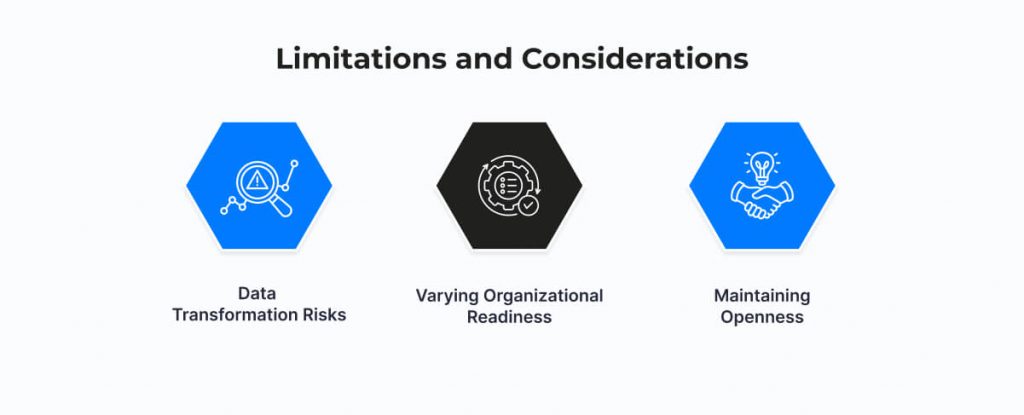
1. Data Transformation Risks
Conversion from one format to another can lead to loss of context or diminished fidelity. Close work is required to decrease transformation mistakes.
2. Varying Organizational Readiness
Not every health system can embrace or incorporate both standards.
Capacity-building and support are required to facilitate successful implementation.
3. Maintaining Openness
Governance needs to remain clear and community-driven.
Collaboration needs to steer clear of commercial bias or proprietary implementations.
Emerging Consensus: Standard Roles by Domain
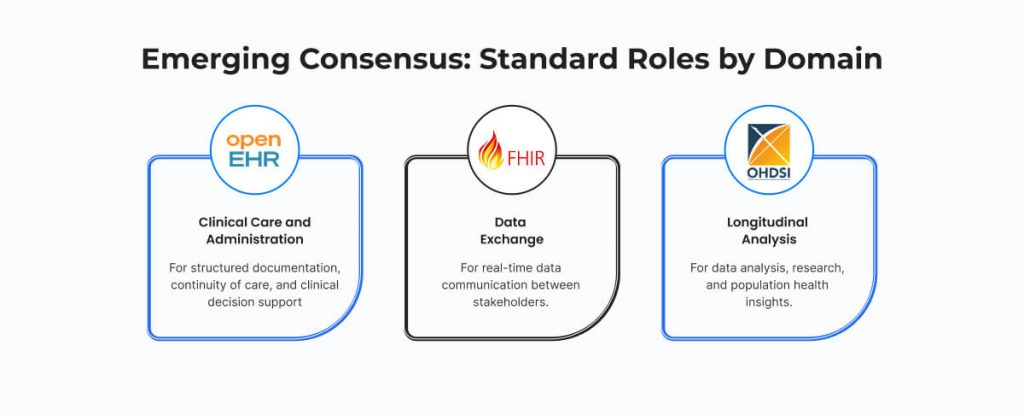
Recent reports from stakeholders on both standards suggest an organized approach:
1. Clinical Care and Administration – openEHR
For systematic documentation, continuity of care, and clinical decision support.
2. Data Exchange – FHIR
or real-time data communication among stakeholders.
3. Longitudinal Analysis – OMOP
For analysis of data, research, and population health insights.
This allocation of duties recognizes the strengths of both standards and lays the groundwork for coordinated use in national and global health systems.
Final Thoughts
The news from openEHR International and HL7 International signals a step toward pragmatic interoperability.
By combining openEHR’s ability to store structured data with FHIR’s strengths in flexible data exchange, health systems can work toward a modular, scalable, and semantically rich environment.
It reflects a world need for pragmatic interoperability solutions that enable improved care, operational efficiency, and resilience in the health system. The interaction between openEHR and HL7 continues as a beacon of hope.
At OSP, we offer bespoke health tech software solutions, integrating open-source EHR software and FHIR standards.
Are you ready to future-proof your healthcare data systems? Let’s create a connected, effective, and patient-focused health ecosystem together.
References
- https://www.hl7.org/implement/standards/product_brief.cfm?product_id=491
- https://pubmed.ncbi.nlm.nih.gov/10639827/
- https://openehr.org/data-for-life-a-2040-vision-for-healthcare/
The post FHIR vs OpenEHR: Decoding the Best Path to Scalable Health Data Integration appeared first on Osplabs.
